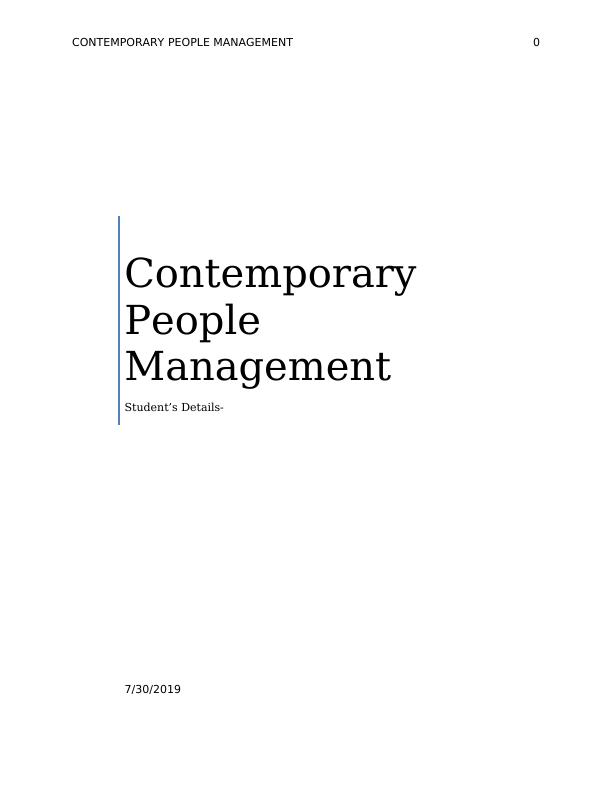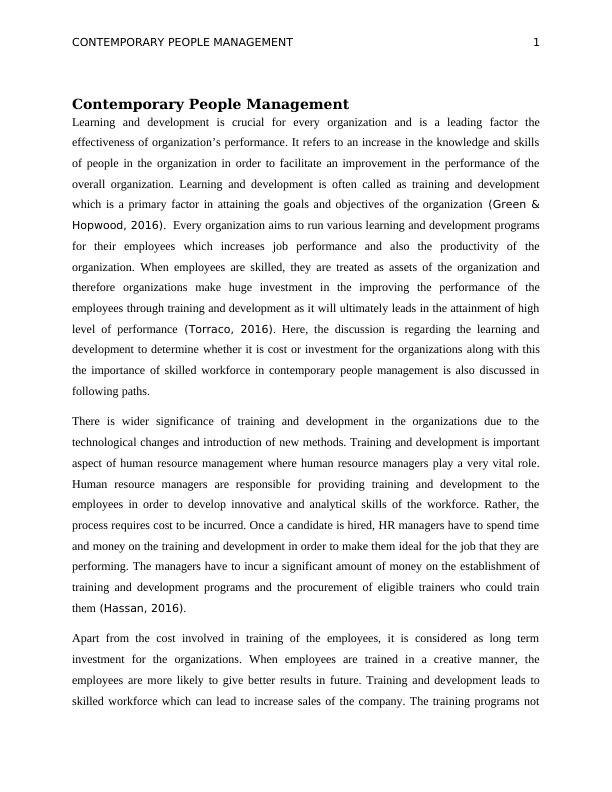Contemporary People Management Article 2022
The article discusses the threats to moral agency posed by social structures.
7 Pages2088 Words18 Views
Added on 2022-10-13
Contemporary People Management Article 2022
The article discusses the threats to moral agency posed by social structures.
Added on 2022-10-13
ShareRelated Documents
CONTEMPORARY PEOPLE MANAGEMENT 0
Contemporary
People
Management
Student’s Details-
7/30/2019
Contemporary
People
Management
Student’s Details-
7/30/2019

CONTEMPORARY PEOPLE MANAGEMENT 1
Contemporary People Management
Learning and development is crucial for every organization and is a leading factor the
effectiveness of organization’s performance. It refers to an increase in the knowledge and skills
of people in the organization in order to facilitate an improvement in the performance of the
overall organization. Learning and development is often called as training and development
which is a primary factor in attaining the goals and objectives of the organization (Green &
Hopwood, 2016). Every organization aims to run various learning and development programs
for their employees which increases job performance and also the productivity of the
organization. When employees are skilled, they are treated as assets of the organization and
therefore organizations make huge investment in the improving the performance of the
employees through training and development as it will ultimately leads in the attainment of high
level of performance (Torraco, 2016). Here, the discussion is regarding the learning and
development to determine whether it is cost or investment for the organizations along with this
the importance of skilled workforce in contemporary people management is also discussed in
following paths.
There is wider significance of training and development in the organizations due to the
technological changes and introduction of new methods. Training and development is important
aspect of human resource management where human resource managers play a very vital role.
Human resource managers are responsible for providing training and development to the
employees in order to develop innovative and analytical skills of the workforce. Rather, the
process requires cost to be incurred. Once a candidate is hired, HR managers have to spend time
and money on the training and development in order to make them ideal for the job that they are
performing. The managers have to incur a significant amount of money on the establishment of
training and development programs and the procurement of eligible trainers who could train
them (Hassan, 2016).
Apart from the cost involved in training of the employees, it is considered as long term
investment for the organizations. When employees are trained in a creative manner, the
employees are more likely to give better results in future. Training and development leads to
skilled workforce which can lead to increase sales of the company. The training programs not
Contemporary People Management
Learning and development is crucial for every organization and is a leading factor the
effectiveness of organization’s performance. It refers to an increase in the knowledge and skills
of people in the organization in order to facilitate an improvement in the performance of the
overall organization. Learning and development is often called as training and development
which is a primary factor in attaining the goals and objectives of the organization (Green &
Hopwood, 2016). Every organization aims to run various learning and development programs
for their employees which increases job performance and also the productivity of the
organization. When employees are skilled, they are treated as assets of the organization and
therefore organizations make huge investment in the improving the performance of the
employees through training and development as it will ultimately leads in the attainment of high
level of performance (Torraco, 2016). Here, the discussion is regarding the learning and
development to determine whether it is cost or investment for the organizations along with this
the importance of skilled workforce in contemporary people management is also discussed in
following paths.
There is wider significance of training and development in the organizations due to the
technological changes and introduction of new methods. Training and development is important
aspect of human resource management where human resource managers play a very vital role.
Human resource managers are responsible for providing training and development to the
employees in order to develop innovative and analytical skills of the workforce. Rather, the
process requires cost to be incurred. Once a candidate is hired, HR managers have to spend time
and money on the training and development in order to make them ideal for the job that they are
performing. The managers have to incur a significant amount of money on the establishment of
training and development programs and the procurement of eligible trainers who could train
them (Hassan, 2016).
Apart from the cost involved in training of the employees, it is considered as long term
investment for the organizations. When employees are trained in a creative manner, the
employees are more likely to give better results in future. Training and development leads to
skilled workforce which can lead to increase sales of the company. The training programs not

CONTEMPORARY PEOPLE MANAGEMENT 2
only enhances the skills of the employees but also develops a level of confidence which keeps
them motivated towards the job. Due to lack of training, employees tend to leave their job which
increases the efforts of the HR managers. Hence, organizations have to spend money on hiring of
the relevant candidate which is time consuming as well. When the employees get opportunity to
learn from training and development, then it will add to improvement in the performance. This
states that training and development is investment rather than cost to organizations (Kadiresan,
et al., 2015).
Training and development is avoided by many organizations which can cause serious harm to the
activities of organizations. When employees are not trained, then they might perform the tasks
wrong which affects the quality of work and ultimately influences the customer satisfaction
leading to reduction in sales revenue. Lack of training also demoralizes the employees and often
leads to labor turnover. Thus, organizations can invest in the training and development of the
employees to avoid the losses that are incurred as a result of lack of training and it also enhances
the motivation level of employees which creates job satisfaction. This can create healthy working
environment for the employees which can help in reaching effectiveness in the performance
(Larsen, 2017).
When the organizations are engaged into providing training to employees, then it creates a
feeling of commitment and loyalty in the employees towards the organization also gives an
opportunity to learn and grow while working into the organization. Thus, when employees are
properly trained with the new technologies, then it is long term benefit of the firm rather than
expense. Therefore, organizations make significant investment in training their employees as it
increases effectiveness of the work and also ensures fewer errors which can save the organization
from the upcoming losses (Manresa, et al., 2018).
Further, investment made in training and development is regarded as long-term benefit of the
organizations rather than cost or expense. When employees are given suitable training then they
feel more engaged with the organization which can lead to the achievement of their personal
goals as well the collective goals of the HR managers and the organization. Thus, investing in the
training procedures can improve the financial performance of the company and hence proves to
be a fruitful investment (Vetrakova & Benova, 2017).
only enhances the skills of the employees but also develops a level of confidence which keeps
them motivated towards the job. Due to lack of training, employees tend to leave their job which
increases the efforts of the HR managers. Hence, organizations have to spend money on hiring of
the relevant candidate which is time consuming as well. When the employees get opportunity to
learn from training and development, then it will add to improvement in the performance. This
states that training and development is investment rather than cost to organizations (Kadiresan,
et al., 2015).
Training and development is avoided by many organizations which can cause serious harm to the
activities of organizations. When employees are not trained, then they might perform the tasks
wrong which affects the quality of work and ultimately influences the customer satisfaction
leading to reduction in sales revenue. Lack of training also demoralizes the employees and often
leads to labor turnover. Thus, organizations can invest in the training and development of the
employees to avoid the losses that are incurred as a result of lack of training and it also enhances
the motivation level of employees which creates job satisfaction. This can create healthy working
environment for the employees which can help in reaching effectiveness in the performance
(Larsen, 2017).
When the organizations are engaged into providing training to employees, then it creates a
feeling of commitment and loyalty in the employees towards the organization also gives an
opportunity to learn and grow while working into the organization. Thus, when employees are
properly trained with the new technologies, then it is long term benefit of the firm rather than
expense. Therefore, organizations make significant investment in training their employees as it
increases effectiveness of the work and also ensures fewer errors which can save the organization
from the upcoming losses (Manresa, et al., 2018).
Further, investment made in training and development is regarded as long-term benefit of the
organizations rather than cost or expense. When employees are given suitable training then they
feel more engaged with the organization which can lead to the achievement of their personal
goals as well the collective goals of the HR managers and the organization. Thus, investing in the
training procedures can improve the financial performance of the company and hence proves to
be a fruitful investment (Vetrakova & Benova, 2017).

End of preview
Want to access all the pages? Upload your documents or become a member.
Related Documents
Importance of Skilled Workforce in Contemporary People Managementlg...
|7
|2070
|381
Three Most Important HR Practices for an International Businesslg...
|13
|1222
|352
3 Most Important HR Practices for International Business - Deskliblg...
|15
|702
|60
Training Material for HR Manager at Dorchester Hotellg...
|3
|883
|27
Manage People Performancelg...
|14
|2136
|81
Benefits of HRM Practices for Employers and Employeeslg...
|19
|5772
|39
